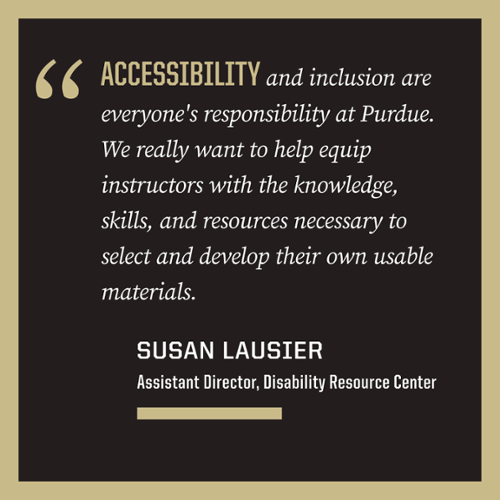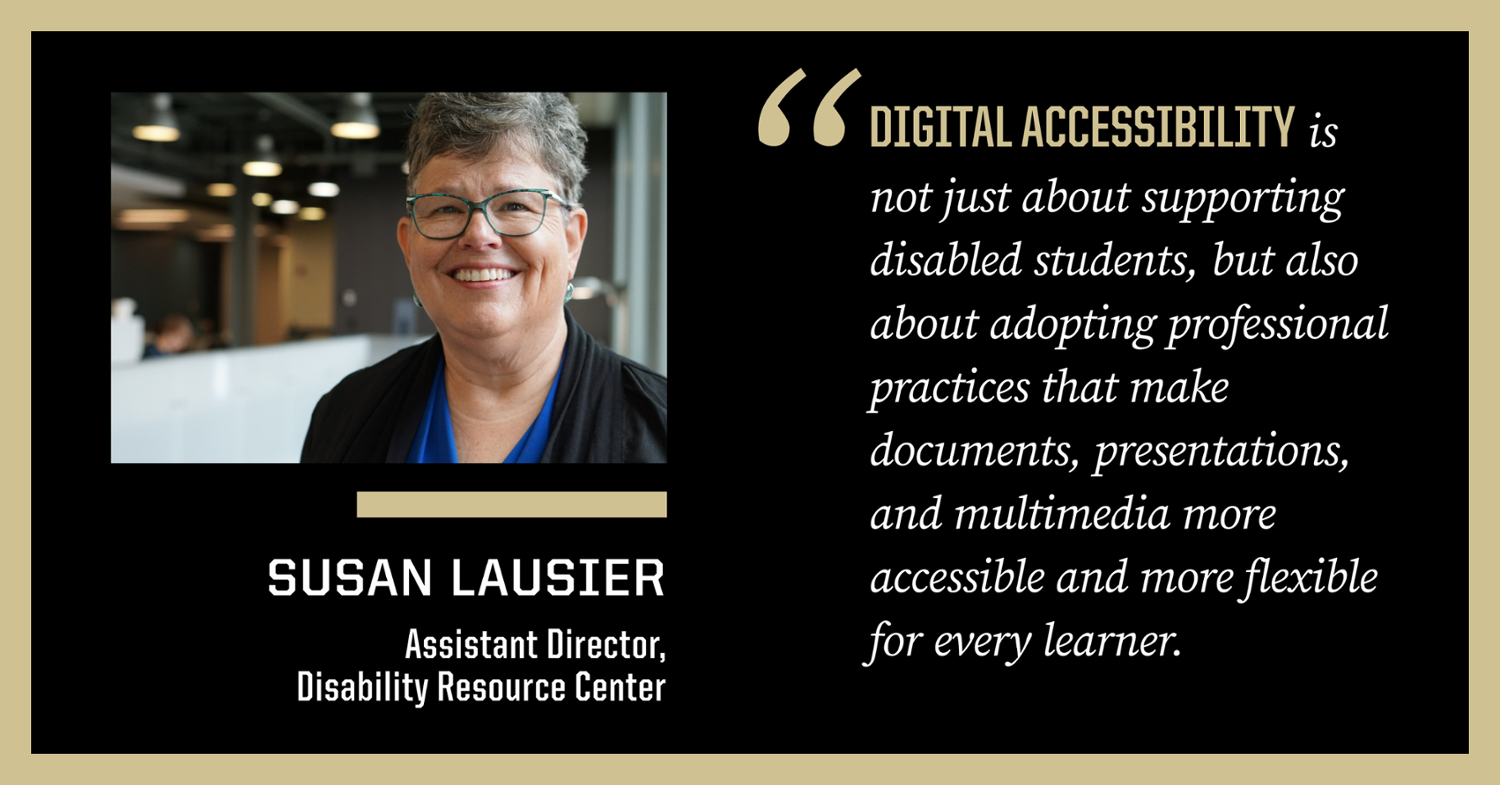
Instructors invited to request help from new Usable Materials Center to make course materials more accessible
Last updated: Sept. 2, 2022
Dan Guberman once heard a student give a talk about her experiences as a dyslexic learner within a text-heavy online learning environment. The student’s story inspired Guberman, a senior instructional developer in Purdue’s Center for Instructional Excellence, to make his own course more accessible by adding audio recordings to complement reading assignments.
Since then, hundreds of students in Guberman’s History of Rock ‘n’ Roll classes have accessed audio and more recently video recordings. Via teaching evaluations and unsolicited feedback, Guberman’s students often note how engaging with the material multiple times, in multiple formats, improved their understanding of course concepts.
Such is the beauty of Universal Design for Learning, says Guberman, who more recently has been reflecting on how his own preferences for consuming scholarship and information have evolved in the past year since he became a parent. He finds himself shifting from online and tactile texts toward audiobooks and podcasts, which better align with his current life circumstances. Guberman says it’s yet another example of how making things more accessible for even one person can create a lot of benefits for others.
“I know I’ll never get to a point where I can make everything about my class perfectly accessible, but I can always try to do a little better,” Guberman says. “Accessibility is such a complex topic, even for someone like me who’s regularly engaged with it; it’s hard to know everything, especially considering how rapidly best practices and conversations related to accessibility are changing as well.”

This fall, instructors at Purdue will have more help, guidance, and support in developing accessible course materials. Purdue’s Disability Resource Center (DRC) recently launched a Usable Materials Center (UMC) to remove barriers for instructors aiming to improve the usability and accessibility of their course materials.
Susan Lausier, who recently was hired as the DRC’s new assistant director, oversees the center, which is now accepting requests for support. One significant aspect of the UMC mission is to take in course materials and convert them into accessible versions at no cost to the instructor.
While material conversion and video captioning services are currently available, Lausier says the center is ramping up to soon provide instructors with:
- Accessibility checks
- Workshops
- Hands-on training
- A physical space on the eighth floor of Young Hall where they can get in-person help
Lausier says the UMC will supplement services already provided by the DRC; existing services include the creation of or conversion to accessible materials for students with disability-related accommodations. However, Lausier say the UMC will broaden the scope of this service to help instructors be more proactive in creating materials that are inherently more usable for all students.
As one example, Lausier says PDFs generally present more accessibility barriers, most commonly due to the inclusion of images, diagrams, or other non-text elements that exclude learners who use screen readers. However, there are steps that can be taken to mitigate those barriers, including having the faculty, as the subject matter expert, add the description of those elements as alternative text in the PDF, thus making it accessible to a screen reader.
“Digital accessibility is not just about supporting disabled students, but also about adopting professional practices that make documents, presentations, and multimedia more accessible and more flexible for every learner,” Lausier says.
Lausier adds that the massive shift to virtual learning during the pandemic was one of the drivers behind the creation of the UMC, along with the DRC’s goal of providing more resources to instructors. Students’ learning environments are evolving to include more multimedia content—videos, pdfs, and websites—that may not be inherently accessible. She says that digital content created without an awareness of accessibility can create unintended barriers. That’s why the UMC will engage faculty in thinking holistically when designing and choosing their course materials—focusing not only on “How do I?” but also “Why do I?”
Although Purdue is responsible for ensuring that all students can access and benefit from an instructor’s course materials and their teaching, there is a timing component as well. The center will aim to support faculty in converting materials proactively, so students don’t have to wait days or weeks to access course content.

“Accessibility and inclusion are everyone’s responsibility at Purdue,” Lausier says. “While the DRC and the UMC will provide the service of converting course materials, we also want to equip instructors with the knowledge, skills, and resources to select and develop their own usable materials on the front-end of the course design process. We also want to foster an ongoing dialogue around this space, and we invite instructors to engage with the UMC in whatever ways will be beneficial to them and their students.”
Linda Prokopy, department head and professor of Purdue’s horticulture and landscape architecture department, says it’s critical that instructors do their part to meet student needs and remove barriers to student success. Prokopy says her experience as former chair of the University’ Senate’s Equity, Diversity and Inclusion Committee, reinforced her perspectives on the importance of accessibility, as well as the importance of recognizing disability as another dimension of diversity.
“I truly believe that instructors have the best interests of students always front and center,” Prokopy says. “However, it can be challenging to create accessible materials given frequent changes in technology and changing expectations and needs. The new Usable Materials Center will provide helpful resources for instructors and pathways to continuously improve our work.”
More information about the Usable Materials Center can be found on the DRC’s website. At this time, individuals may request document remediation via an online form and request video captioning (you must be logged into your Purdue Office 365 account to access the video captioning request form). Staff and instructors may also email the UMC to set up a conversation about how the UMC may be able to support your course accessibility goals.
Writer: Andrea Mattingly, director of communications for Student Success Programs, andrea@purdue.edu
Looking for more resources?
The Disability Resource Center has web pages dedicated to helping staff and instructors create accessible materials, events, and courses. These pages are linked below: